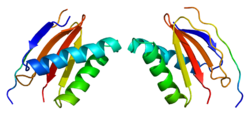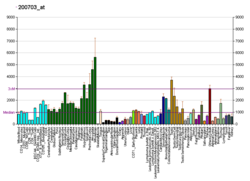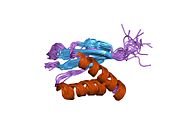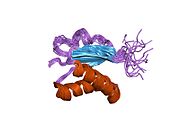DYNLL1
Dynein light chain 1, cytoplasmic is a protein that in humans is encoded by the DYNLL1 gene.[5][6][7][8]
Function[edit]
Cytoplasmic dyneins are large enzyme complexes with a molecular mass of about 1,200 kD. They contain two force-producing heads formed primarily from dynein heavy chains, and stalks linking the heads to a basal domain, which contains a varying number of accessory intermediate chains. The complex is involved in intracellular transport and motility. The protein described in this record is a light chain and exists as part of this complex but also physically interacts with and inhibits the activity of neuronal nitric oxide synthase. Binding of this protein destabilizes the neuronal nitric oxide synthase dimer, a conformation necessary for activity, and it may regulate numerous biologic processes through its effects on nitric oxide synthase activity. Alternate transcriptional splice variants have been characterized.[8]
Interactions[edit]
DYNLL1 has been shown to interact with:
References[edit]
- ^ a b c GRCh38: Ensembl release 89: ENSG00000088986 – Ensembl, May 2017
- ^ a b c GRCm38: Ensembl release 89: ENSMUSG00000009013 – Ensembl, May 2017
- ^ "Human PubMed Reference:". National Center for Biotechnology Information, U.S. National Library of Medicine.
- ^ "Mouse PubMed Reference:". National Center for Biotechnology Information, U.S. National Library of Medicine.
- ^ Dick T, Ray K, Salz HK, Chia W (May 1996). "Cytoplasmic dynein (ddlc1) mutations cause morphogenetic defects and apoptotic cell death in Drosophila melanogaster". Molecular and Cellular Biology. 16 (5): 1966–77. doi:10.1128/mcb.16.5.1966. PMC 231184. PMID 8628263.
- ^ Jaffrey SR, Snyder SH (Nov 1996). "PIN: an associated protein inhibitor of neuronal nitric oxide synthase". Science. 274 (5288): 774–7. Bibcode:1996Sci...274..774J. doi:10.1126/science.274.5288.774. PMID 8864115. S2CID 46494691.
- ^ Pfister KK, Fisher EM, Gibbons IR, Hays TS, Holzbaur EL, McIntosh JR, Porter ME, Schroer TA, Vaughan KT, Witman GB, King SM, Vallee RB (Nov 2005). "Cytoplasmic dynein nomenclature". The Journal of Cell Biology. 171 (3): 411–3. doi:10.1083/jcb.200508078. PMC 2171247. PMID 16260502.
- ^ a b "Entrez Gene: DYNLL1 dynein, light chain, LC8-type 1".
- ^ Day CL, Puthalakath H, Skea G, Strasser A, Barsukov I, Lian LY, Huang DC, Hinds MG (Feb 2004). "Localization of dynein light chains 1 and 2 and their pro-apoptotic ligands". The Biochemical Journal. 377 (Pt 3): 597–605. doi:10.1042/BJ20031251. PMC 1223895. PMID 14561217.
- ^ a b Vadlamudi RK, Bagheri-Yarmand R, Yang Z, Balasenthil S, Nguyen D, Sahin AA, den Hollander P, Kumar R (Jun 2004). "Dynein light chain 1, a p21-activated kinase 1-interacting substrate, promotes cancerous phenotypes". Cancer Cell. 5 (6): 575–85. doi:10.1016/j.ccr.2004.05.022. PMID 15193260.
- ^ a b c Naisbitt S, Valtschanoff J, Allison DW, Sala C, Kim E, Craig AM, Weinberg RJ, Sheng M (Jun 2000). "Interaction of the postsynaptic density-95/guanylate kinase domain-associated protein complex with a light chain of myosin-V and dynein". The Journal of Neuroscience. 20 (12): 4524–34. doi:10.1523/JNEUROSCI.20-12-04524.2000. PMC 6772433. PMID 10844022.
- ^ Diefenbach RJ, Diefenbach E, Douglas MW, Cunningham AL (Dec 2002). "The heavy chain of conventional kinesin interacts with the SNARE proteins SNAP25 and SNAP23". Biochemistry. 41 (50): 14906–15. doi:10.1021/bi026417u. PMID 12475239.
- ^ Crépieux P, Kwon H, Leclerc N, Spencer W, Richard S, Lin R, Hiscott J (Dec 1997). "I kappaB alpha physically interacts with a cytoskeleton-associated protein through its signal response domain". Molecular and Cellular Biology. 17 (12): 7375–85. doi:10.1128/MCB.17.12.7375. PMC 232593. PMID 9372968.
- ^ Herzig RP, Andersson U, Scarpulla RC (Dec 2000). "Dynein light chain interacts with NRF-1 and EWG, structurally and functionally related transcription factors from humans and drosophila". Journal of Cell Science. 113 (23): 4263–73. doi:10.1242/jcs.113.23.4263. PMID 11069771.
- ^ Lo KW, Kan HM, Chan LN, Xu WG, Wang KP, Wu Z, Sheng M, Zhang M (Mar 2005). "The 8-kDa dynein light chain binds to p53-binding protein 1 and mediates DNA damage-induced p53 nuclear accumulation". The Journal of Biological Chemistry. 280 (9): 8172–9. doi:10.1074/jbc.M411408200. PMID 15611139.
Further reading[edit]
- Robertson NG, Khetarpal U, Gutiérrez-Espeleta GA, Bieber FR, Morton CC (Sep 1994). "Isolation of novel and known genes from a human fetal cochlear cDNA library using subtractive hybridization and differential screening". Genomics. 23 (1): 42–50. doi:10.1006/geno.1994.1457. PMID 7829101.
- Crépieux P, Kwon H, Leclerc N, Spencer W, Richard S, Lin R, Hiscott J (Dec 1997). "I kappaB alpha physically interacts with a cytoskeleton-associated protein through its signal response domain". Molecular and Cellular Biology. 17 (12): 7375–85. doi:10.1128/MCB.17.12.7375. PMC 232593. PMID 9372968.
- Tochio H, Ohki S, Zhang Q, Li M, Zhang M (Nov 1998). "Solution structure of a protein inhibitor of neuronal nitric oxide synthase". Nature Structural Biology. 5 (11): 965–9. doi:10.1038/2940. PMID 9808041. S2CID 28591803.
- Rodríguez-Crespo I, Straub W, Gavilanes F, Ortiz de Montellano PR (Nov 1998). "Binding of dynein light chain (PIN) to neuronal nitric oxide synthase in the absence of inhibition". Archives of Biochemistry and Biophysics. 359 (2): 297–304. doi:10.1006/abbi.1998.0928. PMID 9808772.
- Fan JS, Zhang Q, Li M, Tochio H, Yamazaki T, Shimizu M, Zhang M (Dec 1998). "Protein inhibitor of neuronal nitric-oxide synthase, PIN, binds to a 17-amino acid residue fragment of the enzyme". The Journal of Biological Chemistry. 273 (50): 33472–81. doi:10.1074/jbc.273.50.33472. PMID 9837926.
- Puthalakath H, Huang DC, O'Reilly LA, King SM, Strasser A (Mar 1999). "The proapoptotic activity of the Bcl-2 family member Bim is regulated by interaction with the dynein motor complex". Molecular Cell. 3 (3): 287–96. doi:10.1016/S1097-2765(00)80456-6. PMID 10198631.
- Liang J, Jaffrey SR, Guo W, Snyder SH, Clardy J (Aug 1999). "Structure of the PIN/LC8 dimer with a bound peptide". Nature Structural Biology. 6 (8): 735–40. doi:10.1038/11501. PMID 10426949. S2CID 30155673.
- Epstein E, Sela-Brown A, Ringel I, Kilav R, King SM, Benashski SE, Yisraeli JK, Silver J, Naveh-Many T (Feb 2000). "Dynein light chain binding to a 3'-untranslated sequence mediates parathyroid hormone mRNA association with microtubules". The Journal of Clinical Investigation. 105 (4): 505–12. doi:10.1172/JCI8557. PMC 289163. PMID 10683380.
- Naisbitt S, Valtschanoff J, Allison DW, Sala C, Kim E, Craig AM, Weinberg RJ, Sheng M (Jun 2000). "Interaction of the postsynaptic density-95/guanylate kinase domain-associated protein complex with a light chain of myosin-V and dynein". The Journal of Neuroscience. 20 (12): 4524–34. doi:10.1523/JNEUROSCI.20-12-04524.2000. PMC 6772433. PMID 10844022.
- Jacob Y, Badrane H, Ceccaldi PE, Tordo N (Nov 2000). "Cytoplasmic dynein LC8 interacts with lyssavirus phosphoprotein". Journal of Virology. 74 (21): 10217–22. doi:10.1128/JVI.74.21.10217-10222.2000. PMC 102062. PMID 11024152.
- Herzig RP, Andersson U, Scarpulla RC (Dec 2000). "Dynein light chain interacts with NRF-1 and EWG, structurally and functionally related transcription factors from humans and drosophila". Journal of Cell Science. 113 (23): 4263–73. doi:10.1242/jcs.113.23.4263. PMID 11069771.
- Haraguchi K, Satoh K, Yanai H, Hamada F, Kawabuchi M, Akiyama T (Nov 2000). "The hDLG-associated protein DAP interacts with dynein light chain and neuronal nitric oxide synthase". Genes to Cells. 5 (11): 905–911. doi:10.1046/j.1365-2443.2000.00374.x. PMID 11122378. S2CID 37107139.
- Lo KW, Naisbitt S, Fan JS, Sheng M, Zhang M (Apr 2001). "The 8-kDa dynein light chain binds to its targets via a conserved (K/R)XTQT motif". The Journal of Biological Chemistry. 276 (17): 14059–66. doi:10.1074/jbc.M010320200. PMID 11148209.
- Yano H, Lee FS, Kong H, Chuang J, Arevalo J, Perez P, Sung C, Chao MV (Feb 2001). "Association of Trk neurotrophin receptors with components of the cytoplasmic dynein motor". The Journal of Neuroscience. 21 (3): RC125. doi:10.1523/JNEUROSCI.21-03-j0003.2001. PMC 6762309. PMID 11157096.
- Fan J, Zhang Q, Tochio H, Li M, Zhang M (Feb 2001). "Structural basis of diverse sequence-dependent target recognition by the 8 kDa dynein light chain". Journal of Molecular Biology. 306 (1): 97–108. doi:10.1006/jmbi.2000.4374. PMID 11178896.
- Bielli A, Thörnqvist PO, Hendrick AG, Finn R, Fitzgerald K, McCaffrey MW (Mar 2001). "The small GTPase Rab4A interacts with the central region of cytoplasmic dynein light intermediate chain-1". Biochemical and Biophysical Research Communications. 281 (5): 1141–53. doi:10.1006/bbrc.2001.4468. PMID 11243854.
- Yu J, Yu L, Chen Z, Zheng L, Chen X, Wang X, Ren D, Zhao S (Mar 2002). "Protein inhibitor of neuronal nitric oxide synthase interacts with protein kinase A inhibitors". Brain Research. Molecular Brain Research. 99 (2): 145–9. doi:10.1016/S0169-328X(02)00104-3. PMID 11978406.
- Fuhrmann JC, Kins S, Rostaing P, El Far O, Kirsch J, Sheng M, Triller A, Betz H, Kneussel M (Jul 2002). "Gephyrin interacts with Dynein light chains 1 and 2, components of motor protein complexes". The Journal of Neuroscience. 22 (13): 5393–402. doi:10.1523/JNEUROSCI.22-13-05393.2002. PMC 6758200. PMID 12097491.















